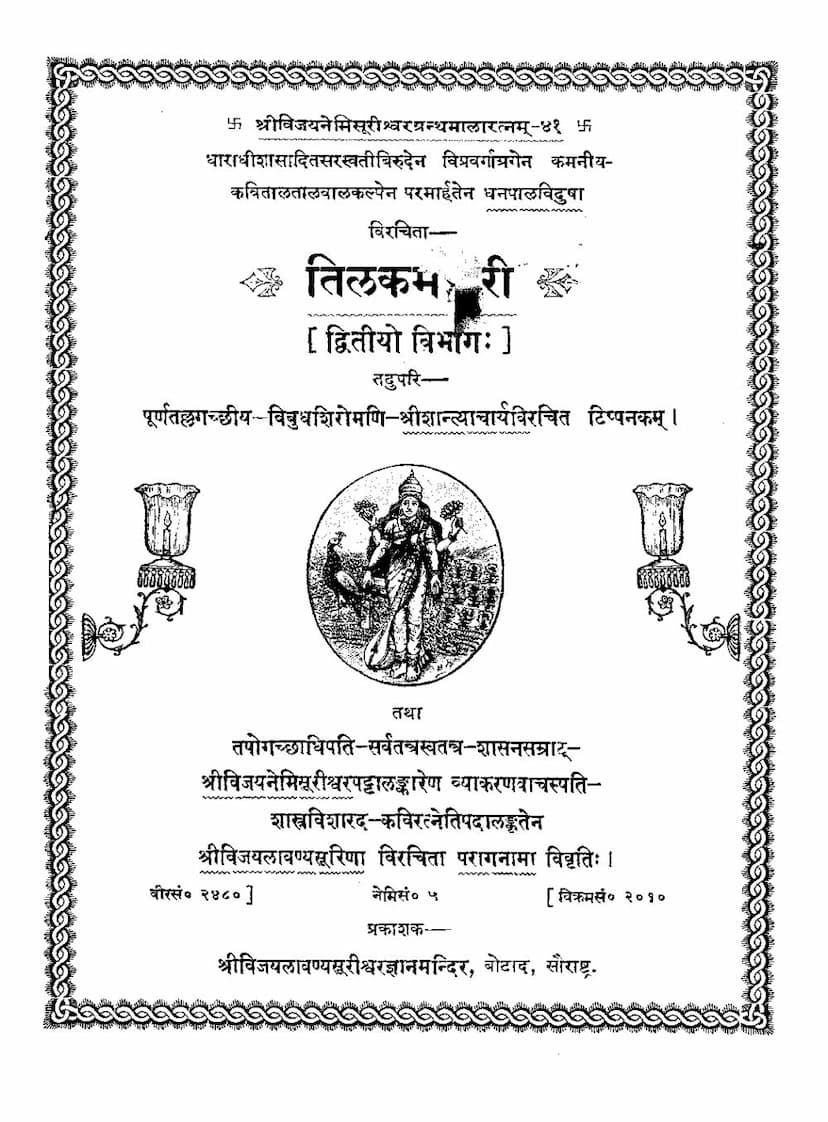Tilakamanjiri Part 2
Added to library: September 2, 2025

Summary
Certainly, here's a comprehensive summary of the provided Jain text, "Tilakamanjari Part 2," based on the given pages and the accompanying summary:
Book Title: Tilakamanjiri Part 2 Author(s): Dhanpal Mahakavi, Shantyasuri, Lavanyasuri Publisher: Vijaylavanyasurishwar Gyanmandir Botad
Overall Summary:
Tilakamanjiri Part 2, the second volume of the epic narrative, continues the story of King Meghavahana and his son Harivahana, weaving a tale rich in royal intrigue, valor, romantic encounters, and philosophical underpinnings, all presented within a framework of Jain principles. The text is a commentary and elaboration on the original work by Dhanpal Mahakavi, with contributions from Shantyasuri and Lavanyasuri.
The narrative focuses on the maturation of Prince Harivahana, his learning, and his eventual involvement in significant political and military events. A key element is the introduction of Prince Samaraketu from Sinhala island, who becomes a close companion to Harivahana. Their interactions and shared experiences highlight themes of friendship, loyalty, and the complexities of human relationships.
The story delves into several intertwined plotlines:
- The Prince's Education and Development: Harivahana undergoes rigorous training in various sciences and arts, demonstrating early signs of his intellectual and martial prowess. His upbringing within the royal palace is detailed, emphasizing the care and attention he receives.
- The King's Wisdom and Foresight: King Meghavahana is portrayed as a wise ruler, concerned with securing the best future for his son and kingdom. His decision to seek a suitable companion for Harivahana and his strategic handling of political matters showcase his leadership qualities.
- The Arrival of Samaraketu: The narrative introduces Samaraketu, a prince from Sinhala, whose arrival marks a significant turn in the story. Their developing friendship and the circumstances surrounding Samaraketu's visit are central to the plot.
- The Tale of Vijayavega and the Ring: A pivotal episode involves Vijayavega, a minister from the southern kingdom of Vajrayudha. He recounts a miraculous event involving a ring sent by King Meghavahana, which proves instrumental in a crucial battle. This story highlights the efficacy of virtuous deeds and divine intervention.
- Samaraketu's Personal Journey: Samaraketu's own narrative is presented, detailing his quest and the events that led him to Kanchi. His story involves artistic pursuits, romantic entanglements, and a profound personal revelation within a sacred grove, emphasizing the importance of spiritual realization.
- The Poetical Discourse: The text features discussions on poetry and its nuances, as exemplified by the interpretation of an Arya verse. This element underscores the cultural and intellectual richness of the period.
- The Kingdom of Kanchi and its Conflicts: The narrative details the military conflicts faced by the kingdom of Kanchi, particularly the battles involving King Kusumasekhara. The bravery of the soldiers and the strategic brilliance of commanders like Vajrayudha are highlighted.
- The Divine Intervention and Fate: Throughout the story, there are instances where seemingly coincidental events or the influence of divine grace (Deva-dvija prasada) play a role in shaping outcomes, reflecting a belief in destiny and spiritual power.
- The Detailed Description of Royal Life and Rituals: The text provides vivid descriptions of royal courts, palaces, festivals, and daily life, offering insights into the customs and traditions of the era. This includes detailed accounts of the preparations for Harivahana's potential coronation and the elaborate rituals surrounding the birth of a royal child.
Key Themes:
- Dharma and Virtue: The importance of righteous conduct, righteousness in action, and the consequences of virtuous and unvirtuous deeds are consistently emphasized.
- Friendship and Loyalty: The strong bond between Harivahana and Samaraketu, and the loyalty shown by characters like Vijayavega, are central.
- Fate and Divine Grace: The text suggests that while human effort is important, divine intervention and destiny also play a significant role in life.
- Aesthetics and Culture: The appreciation for poetry, music, and the arts is evident, showcasing a sophisticated cultural milieu.
- Spiritual Progress: Elements of renunciation, spiritual quest, and the eventual realization of inner peace are woven into the narrative, particularly through Samaraketu's experiences.
In essence, Tilakamanjiri Part 2 is a multifaceted work that blends historical, mythological, and philosophical elements to create a compelling and instructive narrative for its readers.